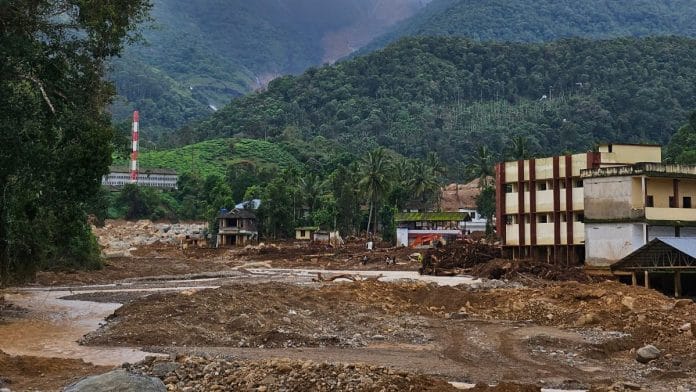Wayanad: Established in 1952, government vocational higher secondary school at Vellarmala is the landmark of Kerala’s Chooralmala town. “It is the only higher secondary school in a 15-km radius,” C. Jayarajan, former headmaster of the school, told ThePrint.
Situated in the foothills of Vellarimala Hills on the banks of the Chooralmala river, the school had over 500 students, from standard 1 to 12, speaking different mother tongues, including Malayalam, Hindi, Tamil, and Kannada.
Today, a part of the school is almost completely buried in mud. The river has claimed the school ground, and nearly 30 students are dead. The landslide that wiped out almost three villages in Wayanad not only buried over 1,000 houses, but also ruined its landmark as old as the region itself.
Even in its devastation, the school stood like a bulwark as it stopped debris from damaging a part of the town — the only section that was left untouched.
The school was not just important for the town, it was a part of the town, Jayarajan said.
The former headmaster, who worked in the school from July 2021 to 2023, said that the locals were actively involved in almost all school activities.
“After the pandemic, the school was reopened in November 2021. In October, the locals had cleaned the entire compound. The collector, who visited the school, even mentioned it and said the school looked like it was continuously functioning,” he added.
Also Read: Wayanad landslides—those who heeded warnings and relocated are among the few who survived
Journey from 8 to 100% pass
T. Basheer, a resident of Meppadi in Wayanad, joined the Vellarmala school in August 2003 to teach Arabic to lower primary students. The teacher was transferred 20 years later, not before he became one of the most familiar and popular faces of Chooralmala.
He witnessed the school’s journey from having a pass percentage below 10 percent in Secondary School Leaving Certificate (SSLC) to 100 percent.
“Most of the students’ parents were tea estate workers who lived in estate paadis (cluster of small houses built for plantation workers by the company), and the facilities available in those houses were limited. Nobody bothered about the situation of education,” Basheer told ThePrint.
At that time, the school was working in shifts for different sections of students due to the lack of space, he recalled. “But the students always excelled in sports. Many represented the school in the state sports fest.”
“The school saw gradual improvement in infrastructure, and a team of teachers that was committed to encouraging the students and their parents joined later,” Basheer said.
“Many of the teachers were staying near the school, too. We went to the students’ houses often and talked to the parents. Every teacher was assigned a group of students as if they were their own children,” he added.
“These teachers constantly interacted with the students for everything from studies to personal matters and helped them.”
There was no ego and the teachers worked together, he added.
“Years later, the school saw a pass percentage of 100 in SSLC exams which continues to date. The number of students with full A-plus saw a gradual increase too.
“We also had a policy to take all students for school tours. If any student was not able to afford the cost, the staff shared it,” Basheer said.
“Once, we all stayed in school for the Onam celebration. The previous night we made a makeshift kitchen and started cooking. Students, locals, and parents participated in it,” he said. “I didn’t have to order the staff for anything, not even once.”
Kept town together
Jayarajan worked in the school for only two years. Before joining the Vellarmala school, he was working at a school in Vythiri village.
“But I felt more satisfied with my job in Vellarmala,” Jayarajan said, adding that the locals, school staff and students shared an intimacy with the school, which involved parents and locals for everything.
Recalling the retirement event held by the staff for him on the school’s annual day, Jayarajan said the event was held as a gramolsavam (festival) and saw nearly 6,000 people attending it.
“We invited everyone. Everyone from Kudumbashree workers to locals participated in events too. There were food stalls set up as well like that of a festival,” Basheer said.
The school was the fulcrum that held an entire town together, which is why the teachers are now uncertain about their favourite school’s future, he said.
“Maybe, it will become Dhanushkodi,” Jayarajan said with a smile.
Located in the southeastern tip of Pamban Island, Dhanushkodi is a town in Tamil Nadu that was abandoned following the 1964 Rameswaram cyclone.
(Edited by Radifah Kabir)
Also Read: Homes lost in sea of mud, Wayanad survivors recall horror, neighbours saying ‘nothing will happen’






